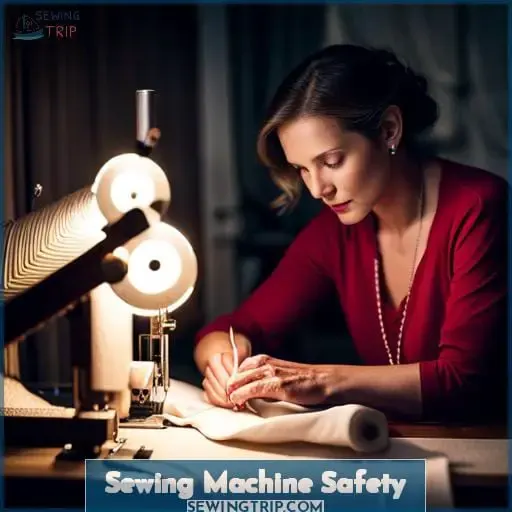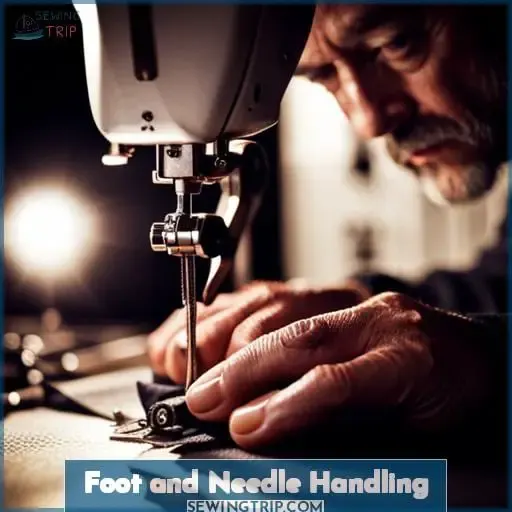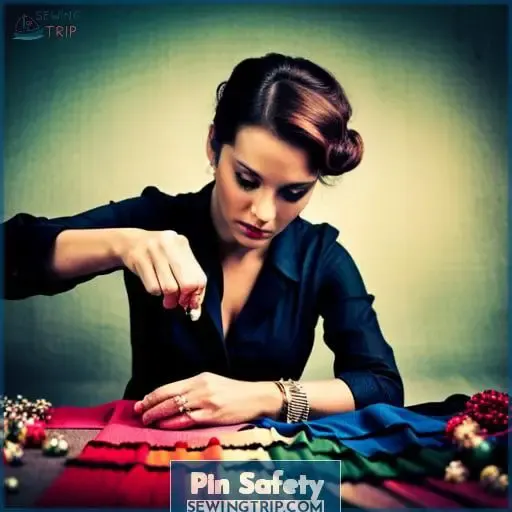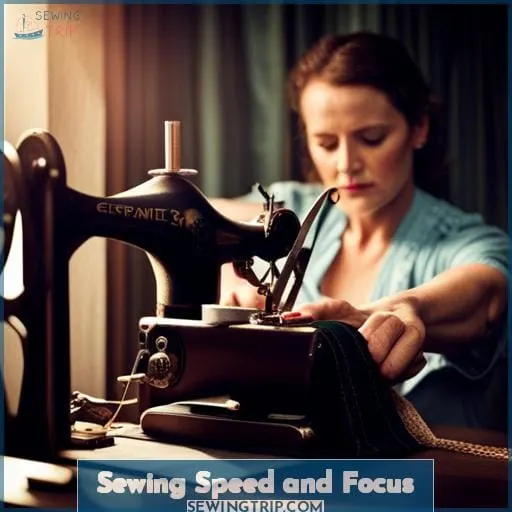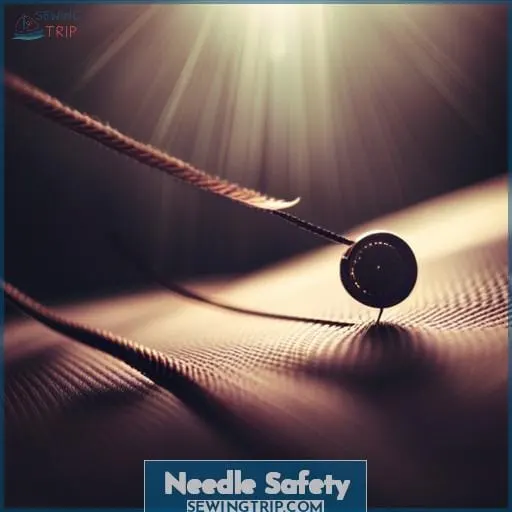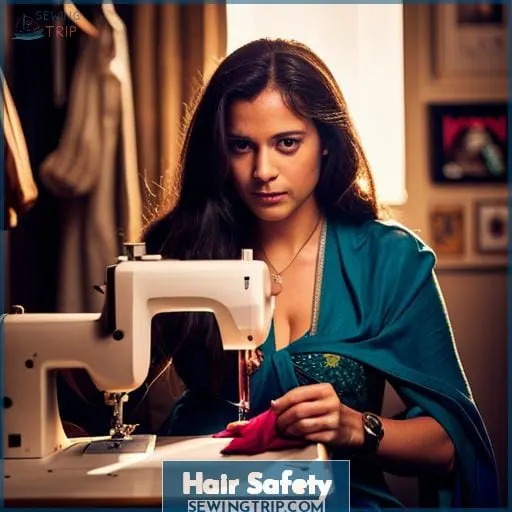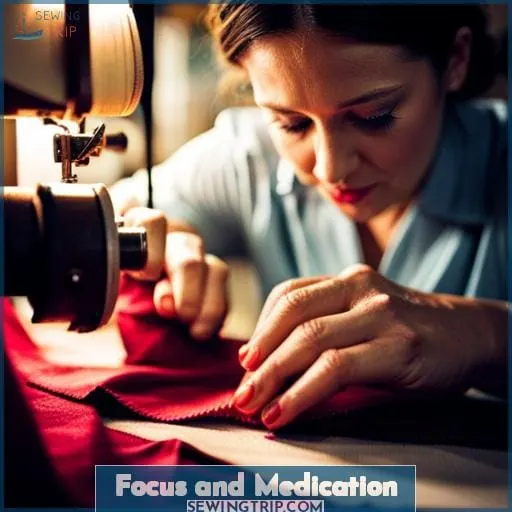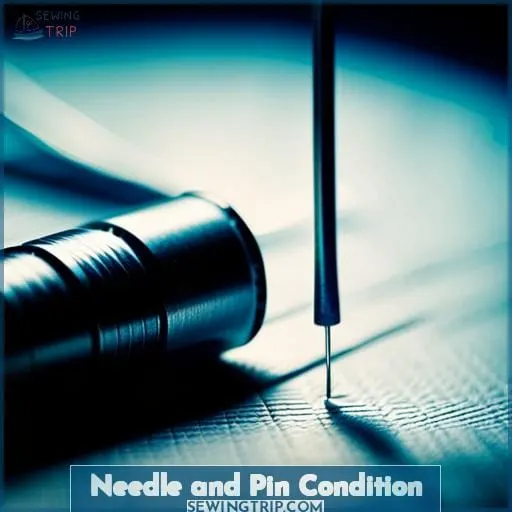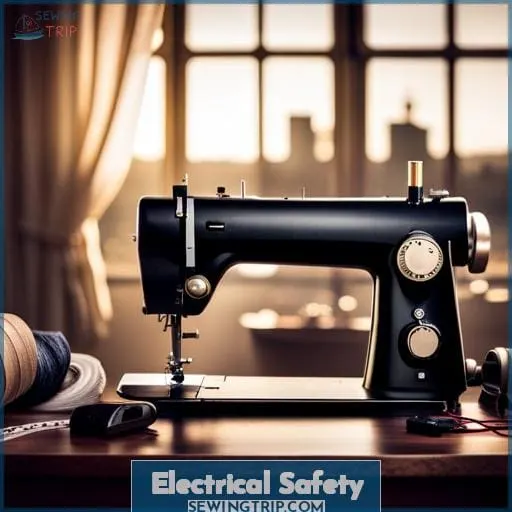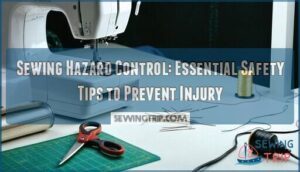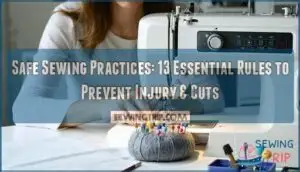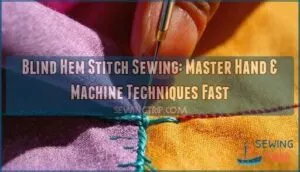This site is supported by our readers. We may earn a commission, at no cost to you, if you purchase through links.
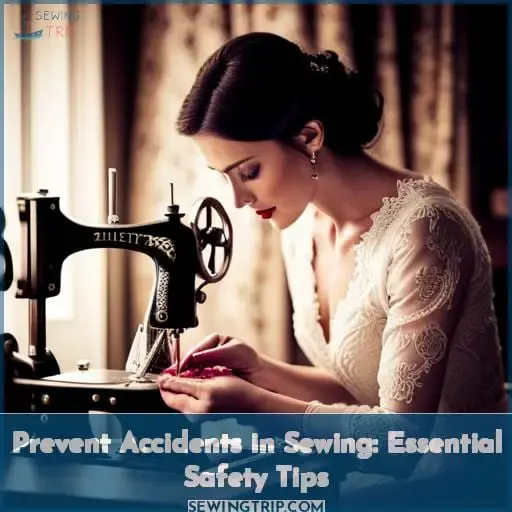 Ready to dive into the world of sewing? Before you thread that needle, it’s important to prioritize safety. Accidents can happen if you’re not careful, but with these essential tips, you’ll be well-equipped to prevent mishaps while stitching away.
Ready to dive into the world of sewing? Before you thread that needle, it’s important to prioritize safety. Accidents can happen if you’re not careful, but with these essential tips, you’ll be well-equipped to prevent mishaps while stitching away.
From proper machine handling and pin safety practices to maintaining good posture and focus, this article will guide you through the key steps for staying safe while pursuing your passion for sewing.
So let’s get started on your journey towards accident-free sewing!
Table Of Contents
Key Takeaways
- Unplug the sewing machine when not in use.
- Choose the correct needle and presser foot for your machine and fabric.
- Maintain proper posture and ergonomics while sewing.
- Keep hair secured and out of the way to avoid accidents.
Sewing Machine Safety
To prevent accidents while using a sewing machine, there are several important safety tips to follow:
First, always remember to unplug your machine when it isn’t in use to avoid shocks and needle accidents.
Additionally, make sure you choose the correct needle for your project and fabric to prevent breakage.
Lastly, regularly check and adjust the tension of your machine to avoid any issues that could lead to needle snapping or other accidents.
By following these simple guidelines, you can ensure a safe sewing experience every time.
Unplug Your Machine When Not in Use
To prevent accidents, always unplug your sewing machine when you’re not using it.
This simple step ensures that the machine is powered off and reduces the risk of electrical hazards.
Consider using a power strip with an on-off switch for added convenience and safety in your sewing workspace.
Use the Correct Needle for Your Project
When using your sewing machine, it’s important to use the correct needle for your project.
Consider fabric compatibility, prevent breakage, ensure needle safety, and choose a needle suitable for your specific project.
Check and Adjust the Tension
To ensure safe sewing machine operation, regularly check and adjust the tension.
Proper tension adjustment prevents needle snapping, ensures smooth stitching, and avoids fabric puckering.
Refer to your machine’s guidelines for best practices in tension adjustment and troubleshooting stitch issues.
Foot and Needle Handling
When it comes to foot and needle handling in sewing, there are a few essential safety tips to keep in mind.
First, always use the appropriate presser foot for your sewing machine brand to ensure smooth and safe stitching.
Second, avoid forcing the foot over obstacles like wires or zippers as this can lead to finger injuries – instead, take the time to carefully maneuver around them.
Lastly, make sure you’re using the correct needle for your project and fabric type to prevent needles from breaking or flying across the room unexpectedly.
Use the Appropriate Presser Foot
When using your sewing machine, always make sure to use the appropriate presser foot for your specific brand and model. This ensures proper stitching and prevents accidents related to incorrect foot attachment or handling.
Choose the right foot, remove pins, and prioritize sewing machine safety.
Avoid Forcing the Foot Over Obstacles
Avoid forcing the foot over obstacles, such as wires or zippers, to prevent finger injuries while sewing.
Take care to navigate around these objects instead of pushing through them.
Prioritize presser foot safety and needle handling for accident prevention.
Ensure Proper Needle Use
Choose the correct needle for your sewing machine to ensure proper needle use and prevent accidents.
- Consider fabric compatibility
- Adjust tension accordingly
- Practice childproofing measures
Regularly maintain needles for optimal safety in your sewing space.
Pin Safety
When it comes to pin safety in sewing, there are a few key tips you should keep in mind.
First, consider using sewing clips instead of pins for added safety.
If you do use pins, make sure to:
- Remove them as you sew.
- Pin them perpendicular to the seam.
- Avoid lazy pinning.
- Take breaks when needed to address and remove pins during your project.
Prioritizing safety by handling pins carefully is essential for accident prevention while sewing.
Consider Using Sewing Clips
By using sewing clips, you can enhance safety when working with pins during your sewing projects.
Sewing clips provide pinless fabric fastening and eliminate the risk of accidental pricks or injuries.
They’re a safer alternative to pins and promote safe sewing practices.
Remove Pins as You Sew
As you sew, ensure pin safety by removing pins as you go. This safe sewing practice helps prevent accidents and ensures smooth stitching.
By following proper pinning techniques, you can avoid pin accidents and enjoy your sewing hobby with peace of mind.
Avoid Lazy Pinning
To ensure safety while sewing, it’s important to avoid lazy pinning by properly securing pins and removing them as you sew.
- Practice proper pinning techniques for safe sewing habits.
- Organize your pins to prevent accidents or hazards.
- Regularly remove pins from your projects as you work.
Posture and Ergonomics
To prevent accidents and promote optimal sewing conditions, it’s crucial to maintain proper posture and ergonomics.
- Sit up straight with your shoulders back to minimize strain on your neck, shoulders, and back.
- Ensure that your forearms lay flat on the table in front of you for improved stability and control.
- Consider using a lumbar pillow for additional back support to encourage good posture throughout your sewing sessions.
Maintain Proper Posture
Maintain a proper posture while sewing to prevent long-term health issues.
- Sit with your back straight and shoulders relaxed, ensuring that your forearms lay flat on the table in front of you.
- Use a lumbar pillow for added back support.
- Practice healthy sewing habits for ergonomic sewing.
Ensure Forearms Lay Flat on the Table
Keep your forearms flat on the table while sewing to maintain proper posture and minimize strain.
- Table ergonomics
- Proper arm positioning
- Reducing the risk of discomfort or injury
Don’t forget to also prioritize:
- Back support
- Workspace lighting
- Finding a comfortable sewing speed
Use a Lumbar Pillow for Back Support
For better posture and back support while sewing, consider using a lumbar pillow.
Lumbar support is essential for ergonomic sewing, preventing back pain and improving overall comfort.
Invest in your sewing experience by prioritizing proper posture with a supportive lumbar pillow.
Sewing Speed and Focus
When it comes to sewing, rushing through projects can lead to accidents and mistakes.
As an occupational therapist, certified sewing instructor, or home economics teacher, you know the importance of being cautious with fast sewing speeds.
Encourage sewers to take their time and work at a comfortable pace to maintain safety while focusing on the task at hand.
Avoid Rushing Through Projects
Prioritize safety by maintaining a steady and focused pace while sewing.
Avoid distractions and maintain proper pinning techniques to prevent needle accidents.
Stay mindful of your actions and surroundings, working at a safe sewing speed to ensure accuracy and minimize risks.
Be Cautious of Fast Sewing Speeds
As you continue sewing, it’s important to be mindful of maintaining a cautious approach when it comes to fast sewing speeds.
Stay focused on safety.
Handle needles with care.
Take care of your hair.
Ensure medication awareness.
Take Your Time and Work at a Comfortable Pace
Maintaining a comfortable pace while sewing is crucial for preventing accidents and ensuring the quality of your work.
- Work at a comfortable speed
- Handle needles safely
- Prioritize preventing accidents
Needle Safety
To ensure needle safety while sewing, it’s crucial to maintain a safe distance from the needle.
As an occupational therapist or certified sewing instructor, you can advise your students to use specialized tools like fabric guiding tools instead of their fingers when working with the machine.
Emphasize the importance of keeping their fingers away from the needle at all times to prevent potential injuries.
Maintain a Safe Distance From the Needle
To ensure your safety while sewing,
- Always maintain a safe distance of about an inch from the needle.
- Use guiding tools to handle fabric and prioritize finger safety.
- Stay focused on your sewing tasks for optimal control and accident prevention.
Use Specialized Tools for Fabric Guiding
Use fabric guiding tools from a craft store to safely guide your fabric instead of using your fingers. These specialized tools provide added protection for both your fingers and the needle, ensuring safer sewing practices.
- Specialized tools offer precise control over fabric movement.
- They reduce the risk of accidental finger contact with the needle.
- Using these tools promotes better focus on sewing tasks.
- Fabric safety is enhanced when relying on proper techniques rather than manual guidance alone
Keep Fingers Away From the Needle
When sewing, always keep your fingers a safe distance away from the needle to prevent accidents.
Use fabric guiding tools instead of your fingers for precise control and safety.
Prioritize finger safety by maintaining proper needle placement and avoiding unnecessary risks.
Hair Safety
To ensure your safety while sewing, it’s important to take precautions with your hair.
If you have long hair, make sure to secure it with a hair tie before starting any sewing project.
Additionally, avoid leaning over the machine while working and keep your hair well out of the way to prevent entanglement or accidents.
By following these simple steps, you can minimize the risk of injury and create a safer sewing environment for yourself.
Secure Long Hair With a Hair Tie
Secure your long hair with a hair tie before starting any sewing project to ensure hair safety.
Avoid leaning over the machine and keep your focus on the task at hand.
Maintain control by keeping your hair well out of the way during sewing.
Hair can easily get caught in moving parts of a sewing machine, leading to accidents and injuries. To prevent this, it’s important to secure long hair with a hair tie before starting any sewing project.
This simple step helps maintain safety by keeping the hair away from potentially dangerous areas of the machine.
Here are three reasons why securing long hair with a hair tie is essential for safe and accident-free sewing:
- Hair Safety: By tying back your hair, you can help prevent it from getting caught in the moving parts of the sewing machine.
- Focus: When your hair is tied back, you are less likely to be distracted by it. This can help you stay focused on the task at hand and avoid making mistakes.
- Control: When your hair is tied back, you have more control over it. This can help you avoid getting it caught in the sewing machine and can also help you keep it out of the way of your work.
Avoid Leaning Over the Machine While Working
To ensure hair safety while sewing, always avoid leaning over the machine while you’re working. This will help prevent accidents and keep your hair well out of the way of the machine’s mechanisms.
Maintain focus on your work to prioritize safety and minimize risks.
Keep Hair Well Out of the Way
To ensure your safety while sewing, it’s important to keep all hair well out of the way to prevent any potential entanglement with the machine’s mechanisms.
Secure long hair and take necessary hair safety measures to avoid accidents.
Focus and Medication
To prevent accidents in sewing, it’s crucial to maintain focus on your work.
Avoid distractions and give your full attention to the task at hand.
Additionally, refrain from using the sewing machine if you’re under the influence of substances that impair concentration, such as medication.
Prioritize safety by staying fully alert and aware while sewing to minimize risks and ensure a safe working environment.
Concentrate on Your Sewing Work
Maintain your focus on the sewing work at hand to ensure safe and accurate stitching.
Prioritize safety by staying fully alert and aware of your surroundings.
Remember to also check the condition of your needles regularly for optimal performance and safety.
Additionally, be cautious with electrical components to prevent any potential hazards while operating the sewing machine.
In addition to preventing external disturbances, it is essential to not only maintain hair safety but also consider needle conditions when focusing on your sewing tasks effectively.
Hair has its own way of seeking adventure during our daily activities—sewing included! To avoid entanglement mishaps where long hair gets caught up in moving parts of a machine unexpectedly; secure it with a hair tie before starting any project involving fabric manipulation using machines like these ones designed specifically for stitches – they’ll help keep everything intact without causing unnecessary worry about unwanted interactions between strands & mechanisms!
When handling needles during intense moments focused solely upon achieving professional results through constant practice- always inspect them beforehand due diligence being crucial since broken ones could become projectiles potentially harmful towards both equipment involved plus personal well-being too if left unchecked entirely disregarded leading onto unfortunate consequences arising subsequently thereafter so please take care whilst working diligently ensuring their proper preservation remains paramount importance throughout whole process undertaken conscientiously without exception whatsoever!
Furthermore, electricals are another area requiring one’s utmost awareness because prevention rather than cure should always be preferred especially pertaining matters dealing directly electricity-related concerns connected together creating ideal harmony inside rooms filled dedication providing utmost comfort ensuring entire environment remains safe secure from unexpected dangers lurking around corners unforeseen.
To ensure electrical safety, always be cautious when operating sewing machines that are connected to power sources. Avoid overloading electrical circuits by using the appropriate outlets and not plugging in too many devices at once.
It’s also crucial to inspect cords for any signs of fraying or damage before use, as these can pose serious risks if left unattended.
By maintaining focus on your sewing work, preventing distractions like hair interference and keeping an eye on needle conditions and electrical safety measures in place; you can create a safer environment where accidents are less likely to occur.
Avoid Sewing While Under the Influence
While you’re working on your sewing projects, avoid sewing under the influence of alcohol or medication.
Maintain focus and stay alert to prevent accidents.
Prioritize safety by avoiding distractions and ensuring sobriety while sewing.
Be aware of potential side effects from medications that may impact your ability to concentrate.
Prioritize Safety by Staying Fully Alert
Stay fully alert while sewing to prioritize safety and minimize the risk of accidents.
Stay focused on your work, avoiding distractions that can lead to needle-related injuries or electrical hazards.
Take precautions for needle safety and protect your hair from getting caught in the machine’s mechanisms.
Needle and Pin Condition
To ensure safety in sewing, always check all your pins and needles before starting a project. This simple step can prevent the potential danger of broken needles causing harm to both you and your machine.
Additionally, make it a habit to regularly inspect and replace any damaged pins or needles to maintain optimal safety while sewing.
Check All Pins and Needles Before Starting
Before starting your sewing project, make sure to check the condition of all pins and needles.
- Inspect each needle for any signs of damage or wear.
- Ensure that all pins are intact and undamaged.
- Prioritize safety by handling pins and needles carefully.
Prevent the Potential Danger of Broken Needles
Check all your pins and needles before starting to sew to ensure they’re in good condition and prevent the potential danger of broken needles.
| Needle Replacement | Pin Alternatives | Machine Maintenance |
|---|---|---|
| Inspect regularly | Consider sewing clips | Check machine parts |
Regularly Inspect and Replace Damaged Pins or Needles
Make sure you regularly inspect and replace any damaged pins or needles to maintain safety while sewing.
- Check all pins and needles before starting.
- Prevent the potential danger of broken needles.
- Regularly inspect and replace damaged pins or needles for needle maintenance and pin safety.
Electrical Safety
When it comes to electrical safety in sewing, it’s crucial to be cautious.
Always avoid using frayed or damaged cords with your machine.
Regularly inspect the electrical components for any signs of wear or damage.
By taking these precautions, you can ensure a safe and accident-free sewing experience.
Be Cautious With Electricity
To ensure your safety while sewing, be cautious with electricity by following these essential tips.
- Practice proper cord management.
- Regularly inspect and maintain your machine.
- Avoid using damaged cords.
Avoid Using Frayed or Damaged Cords
Ensure your sewing machine’s cords are free from frays or damage to maintain electrical safety.
- Regularly inspect cords for any signs of wear or tear.
- Replace damaged cords immediately to prevent electrical hazards.
- Avoid using extension cords, if possible, and plug directly into a grounded outlet.
- Keep cords away from water and heat sources to avoid potential accidents.
Regularly Inspect Electrical Components of the Machine
Inspect the electrical components of your sewing machine regularly to ensure they’re in proper working condition and free from any potential hazards. Regular maintenance and inspection of these components is crucial for preventing accidents and ensuring safe sewing practices.
Frequently Asked Questions (FAQs)
How can I prevent accidents when using a sewing machine around children?
To prevent accidents when using a sewing machine around children:
- Always unplug the machine when not in use and store it safely.
- Keep needles out of reach.
- Teach kids to respect the machine’s dangers.
What are some tips for preventing accidents related to hair getting caught in the sewing machine?
To prevent accidents related to hair getting caught in the sewing machine:
- Tie back your long hair securely with a hair tie.
- Lean away from the machine while working.
- Stay focused on your task for optimal safety.
Are there any specific precautions I should take to prevent accidents when sewing under the influence of medication?
When sewing under the influence of medication, prioritize safety by:
- Avoiding distractions
- Maintaining focus
Ensure you’re in a clear mental state before operating the machine to minimize accidents and promote safe sewing practices.
How can I ensure the needles and pins I use are in good condition to avoid accidents?
To ensure needle and pin safety, regularly inspect them for any damage or wear. Replace any damaged ones promptly.
Proper storage is essential to prevent accidents.
Prioritize your safety by maintaining good condition and organization of your sewing tools.
What are some important electrical safety measures to consider when using a sewing machine?
To ensure electrical safety while using a sewing machine, remember to:
- Turn it off when not in use.
- Unplug it to prevent overheating.
- Follow the manual for proper operation.
- Inspect cords regularly for damage.
Stay safe!
Conclusion
To prevent accidents in sewing, it’s crucial to prioritize safety at all times.
[Keypoints]By following these essential tips, you can ensure a safe and accident-free sewing experience:
- Take the time to properly handle your sewing machine.
- Use the correct tools and materials.
- Maintain good posture and focus.
- Pay attention to pin safety, needle handling, and electrical safety as well.
By incorporating these practices into your sewing routine, you can enjoy your passion for sewing while staying safe and preventing mishaps.

